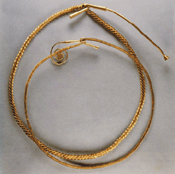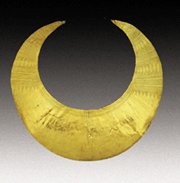|


Since
1984
How our
Jewelry is Made Technique
 |
Jewelry is one
of the oldest forms of decorative art. Seemingly inherent to man's
nature, unconnected civilizations throughout time have each
developed jewelry which reflects their own unique period and
culture. |
| The work of
Gerhard Herbst is primarily concerned with sculptural form and its
aesthetic relationship to the body. Using techniques which have
their origins in Bronze Age British Isle goldsmithing (1400-700
B.C.), Gerhard often forges his jewelry from a single blank of
material, creating dimension and volume through the application of
specialized hammering techniques. In principle, these same
techniques were first employed in ancient Ireland to make jewelry
such as the twisted ribbon torc and the "lunula" neck collar. The
ancient islanders would hammer out their jewelry from a single
ingot, creating pieces that were extremely durable and lightweight.
As a result, hundreds of these pieces still exist and can be found
in museums and private collections. |
|

Twisted Ribbon Torc C. 1200-900 B.C.
Created through a
combination of twisting and hammering the metal.
|

Gold Lunula Neck Collar C. 1800-1500 B.C.
Nearly
symmetrical this piece was well designed for a comfortable
fit.
|
© 1999-2006 Gerhard
C. Herbst. All rights reserved.
|